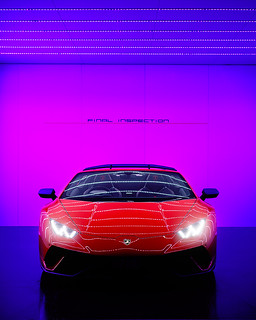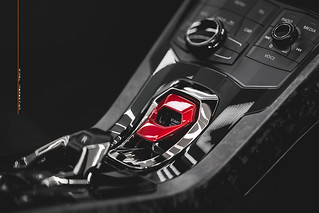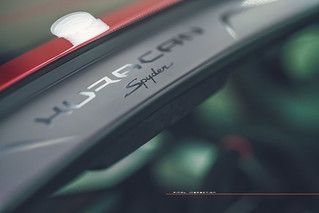The Lamborghini Huracán Performante Spyder, what a mouthful that is.
This beast reminds us of the stunning Lamborghini Gallardo Superleggera, we first detailed that particular uninhibited exotic in early '07, a similarly tricked out, trimmed down, naturally aspirated and track focused but road register-able super car. It's a proven Bolognese recipe we hope Lamborghini keep repeating for as long as possible.

The car is sparse and you know there's always that customer that asks, with a serious face, 'what are you paying for?' We actually think that's a good question, but there's a resoundingly simple answer for this latest Lamborghini product, the engine.

The soundtrack from that naturally aspirated V10 is sinfully intoxicating, it sounds like pure satanic screaming, it just revs and revs and absolutely sings with a raspy, semi Formula 1 sound in its highest rev range. Recorded and played back in reverse, you can clearly hear Lucifer actually recommending the use of car care that isn't Final Inspection approved. True story.

It's not the prettiest car ever made (in our opinion), it's not the fastest, it ain't the most collectable -it probably won't hold any long-term records except that it will very likely be one of the last examples of pure petrol powered excitement. It's a shame the engine is hidden underneath the roof and much more difficult to see in the convertible version.


The owner of this particular example is a driver and has raced alongside some of the most famous names in Australian motor sport as a privateer, putting down some impressive times to boot and, on at least two occasions, made the #DetailStig come very close to properly dirtying his passenger seat if you know what we mean.

DAY ONE : CLEAN, DECONTAMINATE, CORRECT, SEAL
We recently wrote about an Intensive detail on an Edition One C63 wagon and went on and on about the 'piano black' (non-metallic) usually acrylic plastics that are common on the exterior of modern vehicles these days. They are super soft and mark very easily and putting them down low or in high wear areas is frustrating as they mark quickly and look tired before long.
This was the main issue with the Huracán. It had some of these non-metallic black sections and they were hideously marred...

The before shot is AFTER correction with a few different machine methods and is actually better than it was.

In the end, the best solution, pun intended, was to mix a little Dark Matter (1 part) with CAP Ultra Fine (~5 parts) and work it lightly, slowly and for a small amount of time to achieve a flawless finish.

These were attacked first, then we slowly but efficiently went over the entire body with a single pass of CAP Heavy on an Orange HD via rotary. This gave us a one-stepper system that resulted in a good amount of correction without any residual such as hologramming.
With the correction complete we sealed, Full Metal Jacket Paint Protection as per usual. The vehicle then went to sleep in #TheCleanroom at 30 degrees C slowly cooling down to 10 then up to 30 C and down to 10 again.

This temperature cycling accelerates the cure and allows for better performance and durability from the sealant, it also prolongs the life of the sacrificial layer of protection and, allows us to do something new, layering...
DAY TWO : LAYERING AND INTERIOR CLEANING AND PROTECTION
Long time Final Inspection customers will know that layering Dark Matter over FMJ (Full Metal Jacket) Paint Protection isn't something we have recommended. It either didn't adhere properly or ruined the performance of our expensive flagship sealant. We've now solved one of those issues and with this particular type of vehicle, the second isn't so important.
With Dark Matter version 2 (in 2016) came the addition of CAP Ultra Fine abrasives that, when agitated with a machine, allowed some light correction yielding a permanent albeit very light corrective characteristic.
To have DM (Dark Matter) adhere to FMJ we lightly work the product with a machine, very quickly, the abrasives 'bite' into the sealant creating a bond that allows DM to hang on properly and last between 1 (daily drives) and 3 months (weekenders). When it dies it can be re-applied or the FMJ layer simply 'comes back' and starts behaving as it does.

But why Stiggie, why? So much trouble, time and cost.
The benefits of this you ask? Simple. DM yields a jelly gloss to dark coloured cars and anything solid red. It works on almost all colours, but works best on those two types.
FMJ is nice looking and certainly has the durability and longevity everyone enjoys, but the only way to increase the cosmetic punch of this solid (non-metallic) red is to give it the DM loving we desperately want to. Yes, layering DM over FMJ will give the surfaces the washing and wet-weather characteristics of the top layer, which aren't as beneficial as the characteristics FMJ provides, but, since this is a second or third (or forth or fifth) car for this customer and a pure weekender that will see little use especially in bad weather, the priorities for protection are shifted toward looks.

So why not a pure DM finish to save cost and time?
A pure DM finish isn't durable enough, we did say this customer has a few cars and that this won't be used as a daily, but it also won't likely be back to us for some time, if ever and we know that, unfortunately, it'll be washed at a hand car wash somewhere, so it'll be subject to aggressive chemicals that will strip DM from the surfaces in one or two washes and that will leave the customer with a less than satisfactory expectation of a $1,500 Final Inspection detail. He is also a long-term customer, about 15 years and he knows exactly what to expect from two days of our work.

Wheels coated only in FMJ, no dark matter topping here.
So, with the exterior complete and the top layer curing, we get onto the interior, which is a nice place to be. Lamborghini have always been about unabashedly over-styling their cars and the constantly changing angular sheet metal outside with it's hard creases, scoops, honeycomb and many other details are complimented with a similarly styled interior.


Unfortunately we see soft acrylic piano black surfaces in high wear areas again, which looks cool when they are pristine, but are constantly dusty and marked. To repair the marks is an unbelievable process that really requires the removal of the pieces to be done properly. These were in good condition, we gave them some Boost to help keep fingerprints and dust off them.

You can easily get your finger through the hole in the start button cover so you don't have to fingerprint it and all the other buttons can be pressed without leaving a mark if you're careful enough.

The seats are gorgeous. Just perfect. They are clad in Alcantara (or possibly some other high quality knock-off), what we love and hate about Alcantara is that it is perfect for convertibles. It's not cold in winter, nor is it hot in summer, like leather. It's generally (provided it's high quality) as long or longer lasting than leather, easier to clean and it's grippy which is great for performance cars that are driven as they should be.

Unfortunately Alcantara has a nap to it, rub it one way and it has a different darker or lighter look to it, so every time we get in it to move it around or lean on it to tend to the interior we muck up the nappa and that breaks the #DetailStig. Other than that, once the nap is reset by pushing it all in one direction, usually with a slightly damp Interior NanoFibre, the interior is stunning, perfection even. Nothing there shouldn't be, everything there should. We love the mats, they're firm, we've not seen that before, they're so neat.






We'll leave this post here, that's enough for a simple rejuvenation. As usual, we hope you've enjoyed it and learnt something. If you have and would like to support us, you can by purchasing from this site.
To have your ride detailed by the best, contact us.
Image credit: Bespoke Imaging.


Comments
0 comments